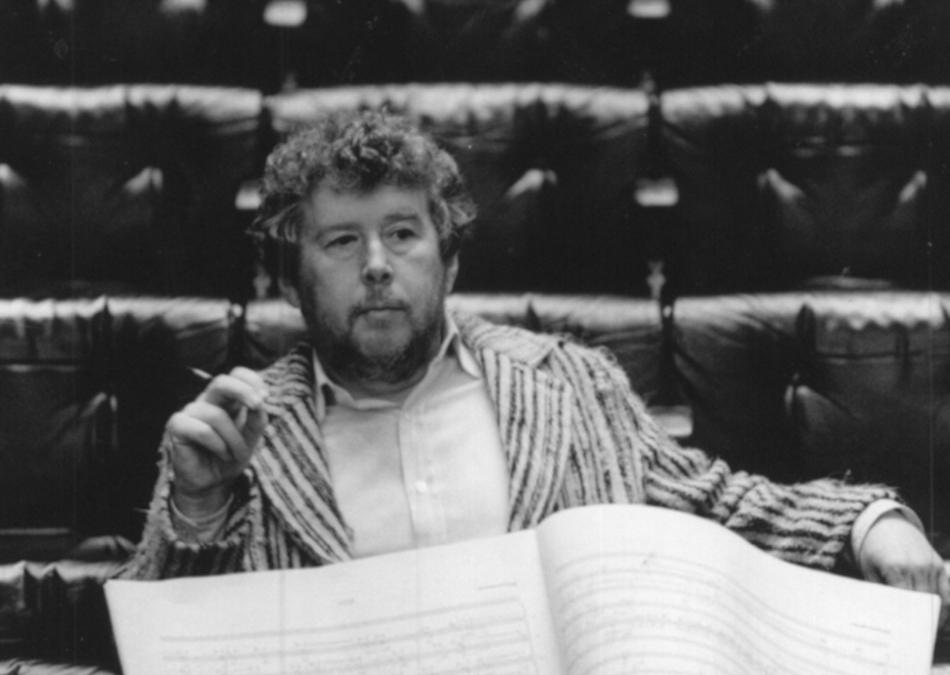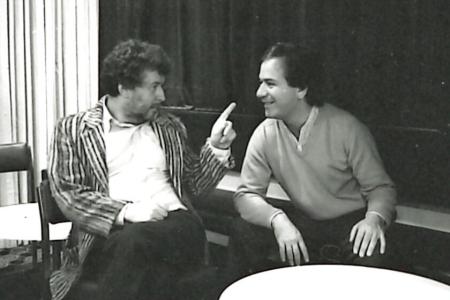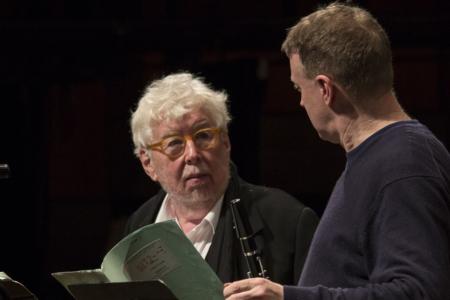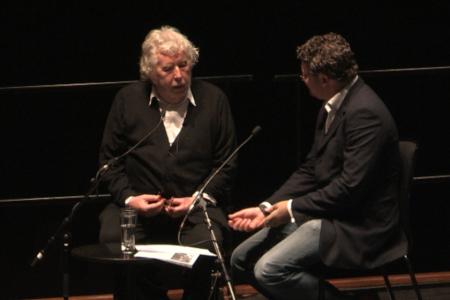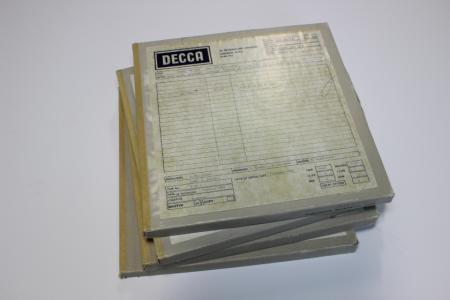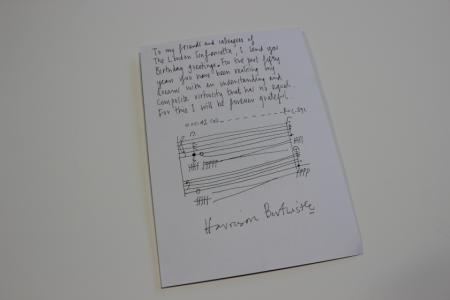Everyone at the London Sinfonietta was deeply saddened by the news of Sir Harrison Birtwistle's death at the age of 87 on 18 April 2022. He was a great friend to the Ensemble for over 50 years, and his music its greatest inspiration. We send our condolences to his family and friends.
On this page we have listed some of the films we have of interviews and performances of his music, as well lists of his compositions for the London Sinfonietta and available recordings. We are also grateful to various people for sending in memories of their time working with Harry. We plan to add more of these memories over the coming weeks.
Scroll down for information on our work with Harry, including:
- Links to interviews and performances of his music on our Channel
- Memories and tributes from:
- David Atherton (conductor & co-founder of the London Sinfonietta)
- Nicholas Snowman (Co-founder of the London Sinfonietta)
- Gillian Moore (Former Artistic Director of the London Sinfonietta)
- Paul Silverthorne (Principal Viola of the London Sinfonietta)
- John Constable (Principal Pianist of the London Sinfonietta for 50 years)
- Geoffrey Paterson (regular London Sinfonietta collaborator)
- Commissions
- Available recordings
Other interviews & performances on the London Sinfonietta Channel
- Five Distances for Five Instruments by Sir Harrison Birtwistle: In Performance
- Five Distances for Five Instruments - Interview with Sir Harrison Birtwistle: Landmarks
- Carmen Arcadiae Mechanicae Perpetuum by Sir Harrison Birtwistle: In Performance
- Cortege by Sir Harrison Birtwistle: In Performance
- Cortege - Interview with Sir Harrison Birtwistle: Landmarks
- Silbury Air by Harrison Birtwistle: Performance Guide
Memories and tributes
It was an immense honour to be able to call Harry a close friend and professional colleague.
Both fairly blunt-speaking Lancastrians, some of our formative years were spent playing clarinet in the Lancashire County Youth Orchestra, he a budding professional, I…well, as Tony Pay remarked, I “never really learnt how to blow it properly”!
Our paths would cross again when, at Cambridge University, I conducted a performance of Harry’s Tragoedia, a fabulous early trial balloon for his opera Punch and Judy, the first performance of which I conducted with the phenomenal English Opera Group at the Aldeburgh Festival in 1968. During eight weeks of rehearsals for Punch, Harry and I “clicked”, his precocious genius infecting everyone around him. His sardonic humour, laced with affection and a deadpan smile, masked a deeply serious composer who knew exactly what he wanted and was often justifiably irritable when we fell short. Back in the 60s stories abounded of his discontented experiences working with large symphony orchestras who found the complexities of his music too much to comprehend, and the technical demands too outrageous. At Aldeburgh, with a long rehearsal period in an idyllic setting and with a small-knit group of singers, players and a production team headed by my great friend, the late Paul Findlay, we were able to forge a focused, intense “family” spirit. Harry was inspiring, yet unforgiving; plentiful with praise whilst being enormously critical; and, above all, showed his genuine gratitude to everyone involved despite never appearing completely satisfied.
(Legend has it that Benjamin Britten sat in his box in the Jubilee Hall for the first night and walked out during the interval as he hated the music and couldn’t take the strident decibel levels being produced in such a tiny, reverberant acoustic. In truth, there was no interval - it’s in one act - and no-one involved in the production ever caught sight of Britten!)
Five months earlier Nicholas Snowman’s and my baby, the Sinfonietta, was born, its inaugural concert containing the première of John Tavener’s The Whale. John’s piece and the Sinfonietta’s formation created quite a stir amongst the national press; this intrigued Harry. I asked him if he’d consider writing a new work, promising a similar “family” spirit to the one we were experiencing at Aldeburgh. My suggestions: no restrictions on orchestration, a substantial work that could fill a second half and one that would be a showcase for instrumental virtuosity. The result, a masterpiece: Verses for Ensembles, an exceptionally influential work that was undoubtedly the major highlight of the Sinfonietta’s second season. Much, much more was to follow. Verses became the first in a long line of commissions from the Sinfonietta, and the beginning of a remarkable partnership that would last for more than half a century.
What a privilege it has been to be trusted and involved with so many wonderful creations. Harry, we miss you.
David Atherton OBE (conductor & co-founder of the London Sinfonietta)
Much has been said naturally enough of Harry Birtwistle’s sheer musical genius
but to those of us to whom he was close, our friend’s extremely joyous appreciation of fine cuisine and exceptional wine will recall wonderful memories.I discovered this essential element in Harry’s nature at our very first meeting. David Atherton was conducting the first and unforgettable performances of Punch and Judy at Aldeburgh shortly after the creation of the London Sinfonietta which we had just formed.
“Nick, let’s commission a new piece designed specifically for the Sinfonietta from Harry Birtwistle”. I duly arranged to meet Harry with Tony Pay and Andrew Rosner, who later became the composer’s long serving and devoted manager. We were young and rather “studenty” young men in those days, sharing a flat in West Hampstead, and lunching modestly in a local pub - Coca Cola mixed with rum was I seem to recall our most sophisticated beverage.
We met Harry as planned at Goodge Street tube station and started looking for a pub in the area. Then the great man’s charming Lancastrian burr was heard suggesting we march a little further and look for “a nice little place I know round the corner”. We ended up experiencing what for us was a totally unknown level of food and drink at the then-renowned L’Etoile in Charlotte Street. An unforgettably enjoyable time was shared, the masterpiece Verses for Ensembles was launched and a bill of £100 arrived.
I left the bill as a vital souvenir of the Sinfonietta’s history in the archive. It represented half the amount of the commission fee, but then this was 1968.
Verses for Ensembles became the Sinfonietta’s main calling card. Thanks to the much missed and adventurous Decca recording manager, James Mallinson, David Atherton’s tremendous recording of the piece with the Sinfonietta appeared along with much else on that courageous and brilliant series of recordings.
The Sinfonietta, as David recalls in his piece, got off to quite a start, with the premiere of John Tavener’s The Whale at the Queen Elizabeth Hall on January 24th, 1968. Soon major composers conducted the new ensemble, in particular Luciano Berio, Pierre Boulez, Hans Werner Henze and Karlheinz Stockhausen. Our first major tour took the Sinfonietta around Europe - the Holland, Florence, Vienna and Tours Festivals under the direction of Pierre Boulez with Verses for Ensembles as our major British work. Harry’s piece was enthusiastically received, and I believe these performances contributed to his rapidly growing reputation as well as “qualifying” this new ensemble for exceptionally generous funding from the British Council. Those were the days….
Food came back in a big way on this tour. Harry travelled with the Sinfonietta, as indeed he would for many happy years. The adventure was due to end in Sviatoslav Richter’s festival in Tours. I heard again the honeyed burr of the great man - “there is a reputed three-star restaurant here in Tours”. Thus, I and the percussion section, but not I imagine Harry, experienced our first three-star restaurant. As the meal proceeded, Harry felt encouraged enough to ask the musicians to play even louder than in the previous performances.
For some composers, creating opera or music-theatre somehow requires a different, separate compositional process from the rest of their output. Harrison Birtwistle, however, like Hector Berlioz and the young Stravinsky, is a composer whose work in whatever form is ‘theatrical’. Some commentators have seen this as a consequence of Birtwistle’s period as music director of the National Theatre, where he spent eight years (from 1975) in a particularly congenial and productive environment; it was there that he composed music for Peter Hall’s production of Aeschylus’s Oresteia, which was to have a great influence on his stage pieces. But even from the 1960s it is clear that Birtwistle’s musical thought is inherently dramatic and that a sense of theatre pervades all his scores.
In Verses for Ensembles the dramatic pattern of his earlier Tragoedia is taken a step further: not only is there a clear differentiation between the ‘roles’ of the instruments, as between protagonist and chorus, but a ‘staging’ is introduced as the players move from place to place in accordance with a prescribed ‘production’. The ensembles of the title are families of instruments – a woodwind quintet (in which each instrument doubles and thus becomes another quintet), a brass quintet and percussion. The quintets are arranged symmetrically and the players move according to whether they are playing high or low instruments. At certain points the two trumpets take up commanding positions and there are sections in which the horn player stands while a succession of instrumentalists play in dialogue with him.
Moving players round became something of a fashion in the 1960s, but in Verses for Ensembles the listener becomes conscious of a ritual being enacted. It seems that a kind of ‘secret theatre’ – to take the title of a later Birtwistle piece – is taking place as the direct function of changes in sonic material, dynamics, timbres and pitches. If the work’s sound-world recalls Edgard Varèse or Oliver Messiaen, there is nothing here of their static juxtaposition of suspended, isolated blocks. For Messiaen, in particular, time stands still in eternity and his universe celebrates fixed truths. In Birtwistle we may hear suggestion of Messiaen and Varèse but we are always conscious of a dynamic process that is inescapably dramatic.
While Birtwistle was alive to ‘European’ influences – other composers’ sound-worlds, the organizational preoccupations of the Darmstadt circle, the distilled poetics of late Stravinsky – he has assimilated aspects of them but still retained his individuality. And his own Englishness, reflected in his interest in such forms as the mummers’ play and in traditional ballads, is a creative stimulus somewhat similar to Béla Bartók’s relationship to his native Hungarian folk culture rather than a representation of some kind of ecological, pastoralizing nostalgia. Thus, a number of Birtwistle’s theatre pieces, the opera Punch and Judy (1966-7), the ‘dramatic pastoral’ Down by the Greenwood Side (1968-9), the ‘music theatre’ Bow Down (1977) and the norther folktale Yan Tan Tethera (1983-4), form an important group of works based in British culture but reflecting a wider range of traditions. If Birtwistle’s instrumental works tend to the condition of ‘secret theatre’, the stage works themselves are like planets encircled by instrumental satellites.
Verses for Ensembles was succeeded by an exceptional series of varied works commissioned by the Sinfonietta over the years. Thus, Harry Birtwistle gave us the profound satisfaction of becoming a continuous and inspiring presence for all.
Nicholas Snowman OBE (Co-founder of the London Sinfonietta)
I took Harry into a secondary school in South East London in the 1990s as part of a Southbank Centre education programme.
I thought that the creative composition work we were doing with the pupils was innovative, but it turned out that he’d done it decades before: when he was teaching music at Cranborne Chase girls’ school in the early 1960s, he got the girls to compose their own music, in groups. “I encouraged them to create music as if music had never existed before,” he told me, “to invent music itself. This was all that I could think of to do with them, but it’s been the most important idea in my music ever since’.It’s no accident that Harry was obsessed with the myth of Orpheus, the inventor of music. Just like he invited those teenage girls to imagine the first music that ever existed, Birtwistle’s own pieces seem to set out to discover music from scratch: the breathing sounds which begin his huge opera The Mask of Orpheus, for example. Or the ticking pulse on the E note which opens Silbury Air, out of which the lines of the music break and swell and grow upwards and outwards to fill the musical space. Or the high flute melody that wafts across the beginning of Secret Theatre like a line drawn in the air. To me, all of these things could be the beginning of music itself. “He’s a kind of Orpheus himself,” said the conductor Elgar Howarth. “He has invented his own way of writing music.”
Birtwistle’s music, despite its surface complexity, relies in fact on his own version of simplicity, what he called ‘going back to the basics of music’. The ideas are often elemental, simple, stripped back. The most basic idea in music is pulse, and pulses in Birtwistle can be layered to create machine-like rhythms, ticking clocks, lumbering geological movements, and imagined mechanical toys, like Paul Klee’s Twittering Machine. Birtwistle’s idea of musical structure is often concerned with blocks of material juxtaposed or layered – yes, in the manner of Stravinsky, Messiaen or Varese, but also in the manner of nature, of layers of rock, of objects in an imagined landscape, of panels of colour in a painting. And the long-breathed melodies which grow and swell and float over so much of Birtwistle’s music may have something in common with his beloved Paul Klee’s lines going for a walk, but they are, for me, also laden with a beautiful and perhaps particularly English melancholy.
Harry once said, “the notion of how you look as opposed to how you listen has always been of great importance to me.” Clearly he was a man of the theatre, from his days as Music Director at the National Theatre to the small-scale music theatre pieces to the huge operas. But his instrumental music also has a kind of ritualised theatre to it; again, something elemental and simple. When we worked with those teenagers in South East London, he got them to create music according to where they happened to be sitting in the room. The space was as important as the sound. And with the big pieces he wrote for the London Sinfonietta, that idea was amplified. In Secret Theatre, if you are playing the melody, you stand on one side of the stage; if you’re playing the accompaniment, you stand on the other; you walk between the two according to the kind of music you’re playing. In Ritual Fragment, a tribute to the Sinfonietta’s late Artistic Director Michael Vyner, each musician walks out of the accompanying ensemble to play their melodic tribute, to lay a musical wreath in honour. Watching Harry in rehearsal was like watching a theatre director, taking in how the performance looked as much as how it sounded.
It has been a privilege to work with him over so many years, at the London Sinfonietta and at the Southbank, to watch him in rehearsal, to spend so many hours talking to him about music and painting and gardens and food and colours, to see the world through his eyes and ears and to be around at the beginning of so much of this miraculous music.
Gillian Moore CBE (Former Artistic Director of the London Sinfonietta)
My first experience, I think, of Harry’s music
was playing in the first performance of Secret Theatre. I’d not before been faced with music of such rhythmic complexity, dramatic power and utter originality. Over the decades the fascination his music had for me has never waned and the experience more recently, of working closely with him on the two chamber operas, The Corridor and The Cure, remains one of the most rewarding experiences of my musical life.Paul Silverthorne (Principal Viola of the London Sinfonietta)
It was with great sadness that I heard that Harry has died.
I remember taking part in so many performances with the Sinfonietta, particularly of the marvellous Silbury Air and Secret Theatre all round the world and of course so many premieres. I think the greatest concert of his music we did was at Snape conducted by Elgar Howarth who conducted so much of his music including all his superb operas, in the interval Harry gave a fascinating interview in which he rather wickedly pretended to forget the names of some famous musicians, very Harry! He will be greatly missed but there is a wonderful store of music for us to listen to.John Constable (Principal Pianist of the London Sinfonietta for 50 years)
Harrison Birtwistle’s music has been of enormous personal significance to me since childhood.
I must have first heard his strikingly distinctive name in the context of the infamous première of Panic at the last night of the 1995 Proms. My family subscribed to BBC Music Magazine, and I remember an article about living composers featuring an unsmiling photo and characteristically gruff quote from him - something about not caring what the audience thinks - so I was aware of him as a fascinating but intimidating figure in the musical landscape.I had just turned 12, a reasonably accomplished pianist and viola player, and also beginning to try my hand at composition. Pastiche Rachmaninoff was my speciality, later moving on to pastiche Stravinsky, and it would have been at least another couple of years before I heard a note of Harry’s music.
A fortuitous event led me to it: out of curiosity I bought a Boosey & Hawkes score of a contemporary work from our local music shop, only for all the pages to fall out on opening it. A polite parental complaint to the publisher brought me not only a replacement, but also a sampler CD of Boosey-published composers as well as a free subscription to Tempo magazine and the Boosey and Hawkes newsletter. The subscription to Tempo and the sampler CD together changed the course of my musical life - Carter is just one of numerous composers I discovered this way, and soon I was trying to pastiche him rather than Rachmaninoff or Stravinsky.
This would have been early in 1998 when I was still 14, as the front page of the first newsletter I received showed a photo of Harry taking applause at the première of Exody in Chicago. Alongside Carter’s Triple Duo (the last couple of minutes of which were on the sampler CD) I made it my business to order the score of Exody, whose composer’s name the perplexed shop assistant wrote down as ‘Bert Whistle’. I taped it when it was broadcast on the radio from the 1998 Proms, and spent the next few months losing myself in this intoxicating musical labyrinth.
In March 1999 the CBSO with Simon Rattle played Earth Dances at the Festival Hall. I must have already heard a radio interview in which Rattle described it as the most difficult piece he’d ever conducted, which surely cannot have been true, but it piqued my interest. I remember the thrilling, convulsing maelstrom of sound, but especially the breath-taking coda where the mechanism slows and eventually disappears. I can still feel my sensation of wide-eyed wonder at the descending flute scale near the end, and the impossibility of breathing as the final hi-hat tap repeats over and over, seemingly for an eternity.
NMC had recently released their famous recording of The Mask of Orpheus - I saw it mentioned in BBC Music Magazine and could tell it was something I needed in my life. By good fortune we lived close to an editor at Universal Edition, who lent me the colossal three-volume score of Orpheus, as well as a score of Earth Dances that was at that time undergoing revision. I lost myself in these works too - a magical, mysterious, unfathomable imaginative world opened up. Only Wagner has ever had such a narcotic effect on me.
The same year, the BBC broadcast a documentary exploring The Triumph of Time, conducted by Boulez (already by then another hero of mine), which introduced me to this work and also for the first time to Harry himself, interviewed in pensive, ironical mood, not at all the aggressive audience-baiter that I had imagined.
As a 16- and 17-year-old I sought out live performances, managing to see Earth Dances again, Melencolia 1, Panic and Endless Parade, as well as Hoquetus Petrus conducted self-effacingly by the composer himself at the Serpentine Gallery as part of a Proms composer portrait. I even took friends to concerts in an occasionally successful attempt to convert them - one non-musician friend can still quote the opening motif of Endless Parade, the best part of a quarter-century later. Playing a CD of Panic to my class in a school lunch-break was, unsurprisingly, not so well-received.
I turned 18 in the summer of 2001, by which point Harry’s music had become inescapably central to my musical, and therefore my personal, identity. The next step was to take the plunge and conduct a work of his, which I did the following April, a performance with university friends of Secret Theatre.
I first spoke to Harry in the foyer of the Festival Hall at a 2003 performance of Earth Dances given by the Philharmonia. In one of the books I had read about his music, the final massive brass crescendo (a unison G-natural) is described, with his agreement, as having a quasi-tonal function. In the revised version this note is a 6th higher, an E-natural. I found this change disappointing! I walked up to him and asked him why he had changed it - he looked at me, bemused, prodded me on the shoulder, said ‘I don’t know…. but I’ll find out!’ and walked away. I still wonder why he changed it, and wish he hadn’t, though his propensity to alter individual pitches in rehearsal with no rationale beyond no longer liking the sound of them was something I later experienced.
Over a decade later I finally properly met and worked with Harry at the time of his 80th birthday concert with the London Sinfonietta, which I shared with David Atherton, and the following year I was honoured to conduct the world première of his chamber opera The Cure, in a double-bill with The Corridor. Spending several weeks in rehearsals with him, even driving him from his London club to Aldeburgh, I got to know him a little. Despite being two rather taciturn people from very different generations, we achieved a familiarity to the point of his berating me in the pub in Aldeburgh for claiming jam should be stored in the fridge (‘Why do you think they’re called preserves?!’).
What I did feel from him, enormously significant for me as someone short of confidence at the best of times, and here working with someone I had idolised for 17 years, was respect and trust, gratitude too. I treasure his dedication in Don Paterson’s translations of Rilke’s Orpheus sonnets, a present to mark the first night of The Cure: ‘The best experience I ever had. You can conduct my music any time’, he wrote. The last time I saw him was in Birmingham in late 2019, where I conducted several of his pieces with BCMG - The Woman and the Hare, Three Songs from the Holy Forest, and the world première of …when falling asleep, which turned out to be one of his last compositions.
Until yesterday I thought of him as the greatest of living composers - this description now has to be recast as one of the great composers of the 20th Century. I already did think of him as a 20th-century composer still writing in the 21st - he belongs in the same breath as Stravinsky, Bartók and Messiaen, and in terms of creative vision, achievement and reach, his work embedded in the repertoire of leading artists and orchestras, he surpasses perhaps any other post-war modernist. Possibly only Ligeti, of the modernists a little older than Birtwistle, has achieved something comparable, but the sheer weight, range and scale of Harry’s oeuvre sets him apart.
His modernism is of a flavour that embraces drama and rejects theory, and perhaps that (along with the unmistakable aural relationship between his idiom and some works by Messiaen and Stravinsky) is one reason for his prominence and, dare I say it, accessibility. Familiar building blocks - harmony, melody and pulse - are remodelled in his music to astonishing, shattering effect in a huge range of works, without ever losing their familiarity; his was a creative imagination that created blazingly powerful musical artefacts whose simultaneous complexity and simplicity defy analysis. His work and life’s achievement, the sense that all this came from one man’s mind and pen, is unfathomable to such a degree that I place him alongside Wagner in my own personal pantheon.
Geoffrey Paterson, 19th April 2022 (Conductor of The Corridor / The Cure and regular London Sinfonietta collaborator)
Commissions (and premiere dates) for the London Sinfonietta
Verses for Ensembles 12 Feb 1969
Prologue 18 Apr 1971
Meridian 26 Feb 1971
Silbury Air 9 Mar 1977
Carmen Arcadiae Mechanicae Perpetuum 24 Jan 1978
Mercure – Poses plastiques 4 Apr 1980
Secret Theatre 18 Oct 1984
Songs by Myself 18 Oct 1984
Four Songs of Autumn 24 Jan 1988
Ritual Fragment 6 May 1990
Slow Frieze 26 Apr 1996
Bach Measures 4 May 1996
Theseus Game 19 Sep 2003
Neruda Madrigales 18 Jun 2005
Cortège 11 Jun 2007
The Message (Duet 1) 2 Dec 2008
Bourdon (Duet 2) 25 Nov 2009
Duet 3 9 Sep 2010
In Broken Images 5 Sep 2011
Duet 4 (Violute) 5 Dec 2014
Duet 5 (Echo) 5 Dec 2014
The Cure (partner piece to The Corridor) 1 Jun 2015
5 Lessons in a Frame 1 Jun 2016
this list includes co-commissions with other ensembles and organisations
Available Recordings with the London Sinfonietta
Punch and Judy
Harrison Birtwistle
Decca, Etcetera, NMC / NMC D138 / 1980
Silbury Air
Harrison Birtwistle
Elgar Howarth conductor
Etcetera / KTC 1052 / 1987
Melancolia
Harrison Birtwistle
Oliver Knussen conductor
NMC / D009 / 1993
Duet 3
Harrison Birtwistle
Gareth Hulse cor anglais
John Orford bassoon
NMC / DL3014 / 2013
Angel Fighter / In Broken Images / Virelais
Harrison Birtwistle
David Atherton conductor
NMC / D211 / 2015
The Message (Duet 1)
Harrison Birtwistle
Alistair Mackie trumpet
Mark van de Wiel clarinet
David Hockings percussion
NMC / DL3021 / 2016
Bourdon (Duet 2)
Harrison Birtwistle
Paul Silverthorn viola
Jonathan Morton violin
NMC / DL3024 / 2016
Duet 4 (Violute)
Harrison Birtwistle
Alexandra Wood violin
Michael Cox flute
NMC / DL3022 / 2016
Duet 5 (Echo)
Harrison Birtwistle
Michael Thompson horn
Byron Fulcher trombone
NMC / DL3023 / 2016
Published: 22 Apr 2022
